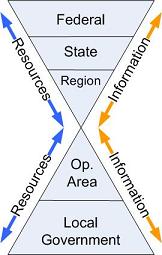Emergency Response
 In the event of a large-scale emergency or disaster, response activities within Tulare County are guided by the Tulare County Emergency Operations Plan (EOP). The EOP, adopted by the Board of Supervisors, implements the California Standardized Emergency Management System (SEMS), and provides organizational structure and functional guidance through the Initial Response, Extended Response, and Recovery phases of operations.
In the event of a large-scale emergency or disaster, response activities within Tulare County are guided by the Tulare County Emergency Operations Plan (EOP). The EOP, adopted by the Board of Supervisors, implements the California Standardized Emergency Management System (SEMS), and provides organizational structure and functional guidance through the Initial Response, Extended Response, and Recovery phases of operations.
The County Administrative Officer (CAO) is the Director of Emergency Services for the Operational Area, assisted by an Emergency Services Coordinator, an Emergency Services Manager, and support staff from the Office of Emergency Services. These individuals manage and coordinate the day-to-day operations and emergency response activities of the emergency organization.
The Emergency Operations Center (EOC) is activated during large emergencies to coordinate the efforts of all responders operating within the county's boundaries (the "Operational Area"). The Operational Area is recognized as a level of the state emergency services organization, and serves to coordinate resources and information between the Local Government level and the Regional level of emergency management. The Tulare Operational Area is comprised of Tulare County, its eight incorporated cities, and all special districts (i.e. utility districts, hospital districts, school districts) and tribes within its boundaries.
 The purpose of an Emergency Operations Center is to manage overall response to one or more incidents within the jurisdiction. An EOC manages an incident by providing coordination of resources and information, and by setting policy and retaining accountability for the outcome. The Emergency Operations Center does not command on-site incident activity, but instead supports Incident Commanders by alleviating many of their administrative / overhead burdens and allowing responders to focus on the task at hand.
The purpose of an Emergency Operations Center is to manage overall response to one or more incidents within the jurisdiction. An EOC manages an incident by providing coordination of resources and information, and by setting policy and retaining accountability for the outcome. The Emergency Operations Center does not command on-site incident activity, but instead supports Incident Commanders by alleviating many of their administrative / overhead burdens and allowing responders to focus on the task at hand.
The Tulare County / Tulare Operational Area Emergency Operations Center (EOC) is strategically and centrally located with a variety of redundant infrastructure connections, making it survivable and sustainable during an emergency or disaster. The facility has dedicated power, computer, network, and telephone equipment capable of operating independent of external systems, along with dedicated microwave, satellite, wireless, and land-mobile voice, data, and radio equipment on-site. The EOC is maintained in a "warm" state, and can be activated within minutes once the need is identified.
Tulare County's Emergency Operations Center is organized as depicted in the Organizational Chart shown here. Click on the diagram to open a larger version in a new window.
For information about current responses, please see the County's Emergencies site.